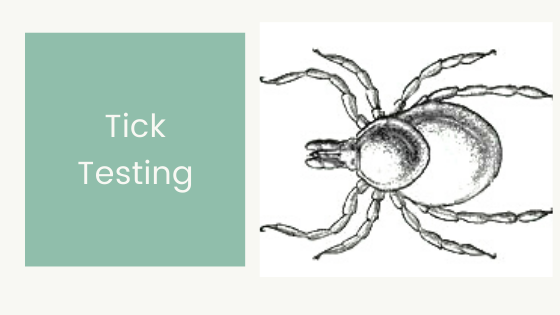
Importance of Tick Testing
Lyme Disease is transmitted to its host (animals or people) by tick bites, most commonly by the black-legged tick (sometimes referred to as ‘deer tick’). Ticks can range in size as they grow from the larva stage to the nymphal stage, until reaching the adult stage. Larva stage ticks are not infected with borrelia burgdorferi (the spiral-shaped bacteria called spirochetes which cause Lyme). It is during the nymphal stage when the ticks feed on the blood of smaller animals such as mice, squirrels, rabbits and birds where they become infected with borrelia. Adult ticks feed primarily on deer, but can be found on dogs, horses, sheep, and of course, people.
Ticks do not fly, but rather crawl, so they lay in wait on the end of a blade of grass or brush waiting to hitch a ride on a potential host. Once attached, ticks remain for several days feeding, then drop off, so the longer a tick remains attached, the more bacteria can be transmitted and the greater the risk of contracting Lyme.
When the tick bites, they release a pain blocker at the site, so the bite is virtually painless to the host, which is why they don’t realize they’ve been bitten. Up to 30% of ticks have been found to carry the borrelia bacteria in Poland. And that is why it is so important to get tested if you have been bitten by a tick. There are different types of tick tests available, but the genetic PCR testing conducted by Blumed genetic laboratory is the only one that gives test results in several days and is considered to be almost 100% effective as you can see from their website – Zbadajkleszcza.pl.

Symptoms of Lyme
Lyme disease ranges from inapparent, to acute, to chronic infections, and the symptoms associated with Lyme disease differ between humans and animals. While skin rashes are characteristic signs of Lyme disease in humans, animals rarely suffer from any kind of Lyme-induced skin rash. The initial stage of Lyme disease in dogs and other animals is associated with changes in their constitution, such as:
- mild fever
- slight depression
- fatigue
- muscle soreness
- reduced appetite
- reoccurring episodes of lameness
The absence of any one sign does not rule out the presence of Lyme disease. Though Lyme can be fatal for dogs, horses, cows and other mammals, its primary symptom is lameness. Infected animals are often stiff and reluctant to move. Their necks appear to ache, their joints remain stiff and they squint when faced with bright light.




